Quick Summary:
- Clearly define your agency and ideal clients.
- Build a user-friendly website with essential content.
- Optimize and promote your site for discovery.
- Track results and continuously improve performance.
Table of Contents
- Chapter 1: Laying the Foundation – Understanding Your Agency and Target Audience
- 1.1 Defining Your Agency’s Identity: The Core of Your Online Presence
- 1.2 Identifying Your Ideal Client: Who Are You Trying to Attract?
- 1.3 Competitive Analysis: Learning from the Best (and Worst)
- Chapter 2: Website Structure and Content Strategy – Building a Solid Foundation
- 2.1 Essential Website Pages: The Core Pillars of Your Online Presence
- 2.2 Developing a Content Calendar: Planning for Success
- 2.3 Keyword Research: Optimizing for Search Engines
- Chapter 3: Design and User Experience – Creating a Lasting Impression
- 3.1 Website Design Principles: Aesthetics and Functionality
- 3.2 User-Friendly Navigation: Guiding Visitors to Their Destination
- 3.3 Optimizing for Speed and Performance: A Fast Website is a Happy Website
- Chapter 4: Technical SEO and Analytics – Making Your Website Discoverable
- 4.1 Technical SEO Best Practices: Ensuring Search Engine Crawlability
- 4.2 Website Analytics: Tracking Your Progress and Measuring Success
- 4.3 Security Considerations: Protecting Your Website and Your Visitors
- Chapter 5: Promoting Your Advertising Agency Website – Driving Traffic and Generating Leads
- 5.1 Search Engine Optimization (SEO): Ranking Higher in Search Results
- 5.2 Social Media Marketing: Engaging with Your Audience on Social Platforms
- 5.3 Paid Advertising (PPC): Reaching a Targeted Audience with Paid Ads
- 5.4 Email Marketing: Nurturing Leads and Building Relationships
- Chapter 6: Maintaining and Updating Your Website – Keeping Your Online Presence Fresh
- 6.1 Regular Content Updates: Keeping Your Website Fresh and Relevant
- 6.2 Monitoring Website Performance: Identifying and Addressing Issues
- 6.3 Gathering Feedback and Making Improvements: Continuous Optimization
- Chapter 7: Qrolic Technologies: Your Partner in Digital Success
- Chapter 8: Measuring Success – Key Performance Indicators (KPIs)
- 8.1 Defining Your KPIs: What Metrics Matter Most?
- 8.2 Tools for Tracking KPIs: Leveraging Data for Insights
- 8.3 Analyzing Data and Making Adjustments: Continuous Improvement
Chapter 1: Laying the Foundation – Understanding Your Agency and Target Audience
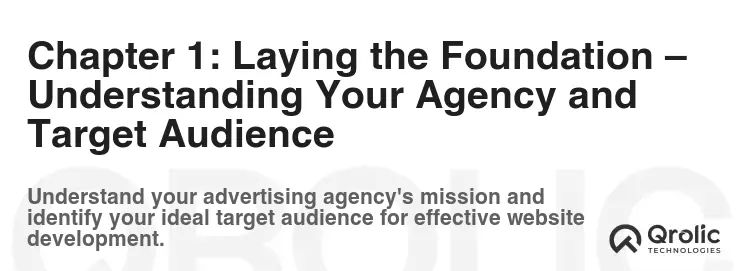
1.1 Defining Your Agency’s Identity: The Core of Your Online Presence
Before even thinking about pixels and code, you need a rock-solid understanding of who your advertising agency is. This isn’t just about what services you offer, but about your core values, your unique selling proposition (USP), and your long-term vision. This understanding will permeate every aspect of your website, attracting the right clients and repelling the wrong ones.
-
What Makes You Different? (USP): In a sea of advertising agencies, what makes you the irresistible choice for a potential client? Are you hyper-focused on a specific niche? Do you have a proprietary methodology? Maybe it’s your award-winning creative team or your data-driven approach. Identify that one thing (or a few things) that truly sets you apart. This is your unique selling proposition (USP) and it needs to be front and center on your website.
-
Your Values: The Guiding Principles: What does your agency believe in? Authenticity? Transparency? Innovation? Clearly defining your values helps attract clients who share those values. Think about the brands you admire – their values likely align with your own. Showcase these values on your “About Us” page and throughout your content.
-
Your Mission & Vision: The Big Picture: Where is your agency heading? What impact do you want to make on the world? Having a clear mission and vision statement helps you stay focused and inspires your team. It also gives potential clients a sense of your long-term commitment and ambition.
Example: Let’s say you’re a digital marketing agency specializing in e-commerce for sustainable brands. Your USP could be your expertise in driving conversions while staying true to ethical and environmentally conscious principles. Your values might include sustainability, transparency, and data-driven decision-making. Your mission could be to help sustainable businesses thrive in the digital landscape.
1.2 Identifying Your Ideal Client: Who Are You Trying to Attract?
You can’t be everything to everyone. Trying to appeal to every potential client will dilute your message and attract the wrong types of projects. Instead, focus on identifying your ideal client profile.
-
Defining Your Buyer Persona: Create a detailed profile of your ideal client. Consider their industry, company size, marketing budget, challenges, and goals. Give them a name, a job title, and even a backstory. The more specific you are, the easier it will be to tailor your website content to their needs.
- Industry Focus: Are you targeting startups, established corporations, or non-profits?
- Company Size: Do you specialize in working with small businesses, medium-sized enterprises, or large enterprises?
- Marketing Budget: What is the typical marketing budget of your ideal client?
- Challenges & Goals: What are their biggest marketing challenges? What are they hoping to achieve with your help?
-
Understanding Their Pain Points: What problems are your ideal clients facing? What keeps them up at night? Address these pain points directly on your website. Show them that you understand their challenges and have the solutions they need.
-
Their Online Behavior: Where do they spend their time online? What keywords are they searching for? Understanding their online behavior will help you optimize your website for search engines and target them with relevant content.
Example: Using the sustainable e-commerce agency example, your ideal client might be a small to medium-sized sustainable fashion brand struggling to stand out in a crowded online market. Their pain points might include low website traffic, low conversion rates, and difficulty communicating their brand values effectively. They might be searching for terms like “sustainable e-commerce marketing,” “ethical SEO,” and “green website design.”
1.3 Competitive Analysis: Learning from the Best (and Worst)
Don’t reinvent the wheel. Analyze your competitors’ websites to see what they’re doing well (and what they’re doing poorly). This isn’t about copying them, but about identifying best practices and finding opportunities to differentiate yourself.
- Identify Key Competitors: Who are the top advertising agencies in your niche or geographic area?
- Analyze Their Websites: What is their website design like? What services do they offer? What kind of content do they publish? How do they position themselves?
- Identify Strengths and Weaknesses: What are your competitors doing well? What could they be doing better?
- Find Opportunities to Differentiate: How can you offer something unique that your competitors don’t? What unmet needs can you address?
Example: Analyze the websites of other digital marketing agencies that focus on sustainable businesses. What kind of case studies do they showcase? What keywords are they targeting? How do they communicate their values? Look for gaps in their offerings or areas where you can provide a superior experience.
Chapter 2: Website Structure and Content Strategy – Building a Solid Foundation
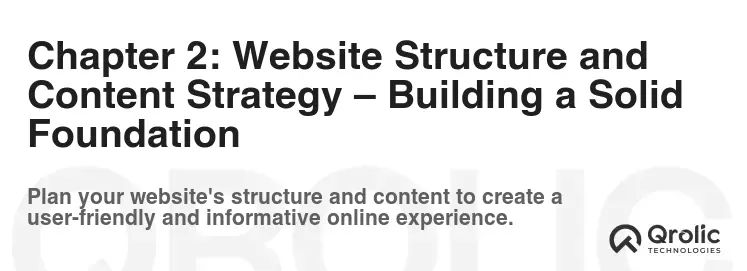
2.1 Essential Website Pages: The Core Pillars of Your Online Presence
Every advertising agency website needs certain essential pages to effectively communicate its value and attract potential clients. These pages serve as the foundation of your online presence and should be carefully crafted to meet the needs of your target audience.
-
Homepage: Your website’s front door. It needs to immediately grab the visitor’s attention and clearly communicate what you do, who you serve, and why they should choose you. A strong headline, compelling visuals, and a clear call to action are essential. This is the first impression; make it count.
- Headline: A clear and concise statement that immediately communicates your value proposition.
- Visuals: High-quality images and videos that showcase your work and brand personality.
- Call to Action (CTA): Encourage visitors to take the next step, such as “Get a Free Consultation” or “View Our Portfolio.”
-
About Us: Tell your story. Share your agency’s history, values, mission, and vision. Introduce your team and highlight their expertise. This page is all about building trust and credibility.
- Agency History: Share your agency’s origin story and key milestones.
- Team Bios: Introduce your team members and highlight their expertise and experience.
- Values & Culture: Communicate your agency’s core values and company culture.
-
Services: Clearly outline the services you offer and how they can benefit your clients. Use persuasive language and compelling visuals to showcase your expertise.
- Service Descriptions: Provide detailed descriptions of each service you offer.
- Benefits-Oriented Language: Focus on the benefits of your services rather than just the features.
- Case Studies: Showcase your success stories with relevant case studies.
-
Portfolio/Case Studies: Show, don’t tell. Showcase your best work and demonstrate the results you’ve achieved for your clients. Include detailed descriptions of each project and highlight the challenges you overcame.
- High-Quality Visuals: Use stunning images and videos to showcase your work.
- Detailed Descriptions: Provide context for each project and highlight the challenges you overcame.
- Results & Metrics: Quantify the results you achieved for your clients (e.g., increased website traffic, higher conversion rates).
-
Blog: Share your expertise and insights through informative and engaging blog posts. This is a great way to attract new visitors to your website and establish yourself as a thought leader in your industry. Content is king, and a blog is your kingdom.
- Relevant Topics: Write about topics that are relevant to your target audience and their pain points.
- SEO Optimization: Optimize your blog posts for search engines by using relevant keywords.
- Call to Action: Include a call to action at the end of each blog post to encourage visitors to take the next step.
-
Contact Us: Make it easy for potential clients to get in touch with you. Include a contact form, phone number, email address, and social media links.
- Contact Form: A simple and easy-to-use contact form.
- Phone Number & Email Address: Clearly displayed and easy to find.
- Social Media Links: Connect with your audience on social media.
2.2 Developing a Content Calendar: Planning for Success
A content calendar is an essential tool for planning and managing your website content. It helps you stay organized, consistent, and focused on your goals.
- Identify Target Keywords: Research the keywords your target audience is searching for and incorporate them into your content calendar. Keywords are the breadcrumbs that lead clients to your door.
- Brainstorm Content Ideas: Generate a list of potential blog posts, case studies, and other content assets that are relevant to your target audience.
- Schedule Content Creation: Assign deadlines for each piece of content and track your progress.
- Promote Your Content: Plan how you will promote your content on social media and other channels.
Example: Your content calendar might include blog posts on topics like “5 Ways Sustainable Brands Can Improve Their E-commerce SEO,” “Case Study: How We Increased Website Traffic by 200% for a Sustainable Fashion Brand,” and “The Ultimate Guide to Green Website Design.”
2.3 Keyword Research: Optimizing for Search Engines
Keyword research is the process of identifying the keywords that your target audience is searching for and incorporating them into your website content. This is essential for attracting organic traffic from search engines.
- Use Keyword Research Tools: Use tools like Google Keyword Planner, SEMrush, and Ahrefs to identify relevant keywords.
- Focus on Long-Tail Keywords: Long-tail keywords are longer, more specific phrases that are less competitive and more likely to convert.
- Analyze Your Competitors’ Keywords: See what keywords your competitors are targeting and identify opportunities to differentiate yourself.
- Incorporate Keywords Naturally: Don’t stuff your content with keywords. Use them naturally and strategically throughout your website.
Example: For the sustainable e-commerce agency, relevant keywords might include “sustainable e-commerce marketing,” “ethical SEO,” “green website design,” “eco-friendly advertising,” and “conscious consumer marketing.”
Chapter 3: Design and User Experience – Creating a Lasting Impression
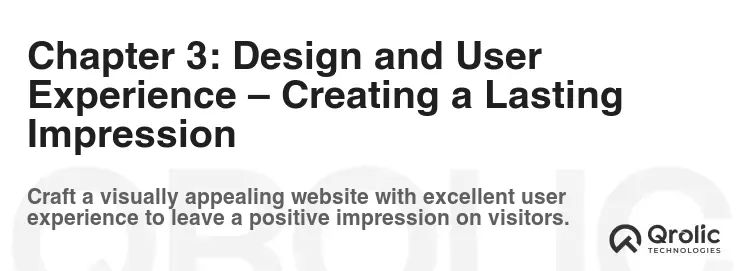
3.1 Website Design Principles: Aesthetics and Functionality
Your website design should be both aesthetically pleasing and functionally effective. It should reflect your brand personality and provide a seamless user experience.
- Visual Hierarchy: Use visual cues like size, color, and placement to guide the user’s eye and highlight important information.
- White Space: Use white space to create a clean and uncluttered design that is easy to read and navigate. Don’t be afraid of empty space; it helps the important elements stand out.
- Color Palette: Choose a color palette that is consistent with your brand and evokes the desired emotions.
- Typography: Use clear and legible fonts that are easy to read on all devices.
- Mobile Responsiveness: Ensure that your website is fully responsive and looks great on all devices, including smartphones, tablets, and desktops.
3.2 User-Friendly Navigation: Guiding Visitors to Their Destination
Your website navigation should be intuitive and easy to use. Visitors should be able to find what they’re looking for quickly and easily.
- Clear and Concise Menu: Use a clear and concise menu that is easy to understand.
- Logical Site Structure: Organize your website content in a logical and intuitive way.
- Search Functionality: Provide a search function that allows visitors to easily find specific information.
- Breadcrumbs: Use breadcrumbs to show visitors where they are on your website.
3.3 Optimizing for Speed and Performance: A Fast Website is a Happy Website
Website speed and performance are crucial for user experience and SEO. A slow website can frustrate visitors and hurt your search engine rankings.
- Optimize Images: Compress your images to reduce file size without sacrificing quality.
- Minimize HTTP Requests: Reduce the number of HTTP requests by combining files and using caching.
- Use a Content Delivery Network (CDN): Use a CDN to distribute your website content across multiple servers, reducing latency and improving load times.
- Choose a Fast Hosting Provider: Choose a hosting provider that offers fast servers and reliable uptime.
Chapter 4: Technical SEO and Analytics – Making Your Website Discoverable
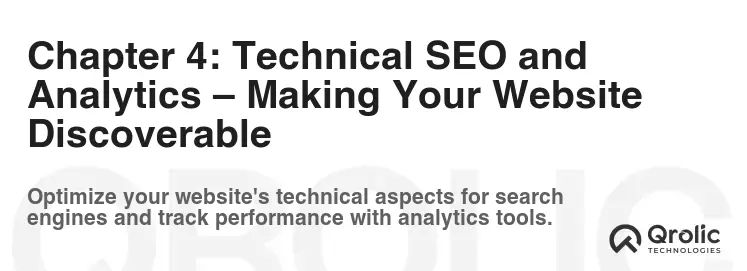
4.1 Technical SEO Best Practices: Ensuring Search Engine Crawlability
Technical SEO involves optimizing your website’s technical aspects to make it easier for search engines to crawl and index your content.
- XML Sitemap: Create an XML sitemap and submit it to search engines to help them discover your website’s pages.
- Robots.txt: Use a robots.txt file to control which pages search engines can crawl.
- Schema Markup: Implement schema markup to provide search engines with more information about your content.
- Mobile-First Indexing: Ensure that your website is mobile-friendly, as Google now uses mobile-first indexing.
4.2 Website Analytics: Tracking Your Progress and Measuring Success
Website analytics tools like Google Analytics provide valuable insights into your website’s traffic, user behavior, and performance.
- Set Up Google Analytics: Install Google Analytics on your website to track your traffic and user behavior.
- Track Key Metrics: Monitor key metrics like website traffic, bounce rate, conversion rate, and time on page.
- Analyze User Behavior: Understand how users are interacting with your website and identify areas for improvement.
- Set Goals and Track Conversions: Set goals in Google Analytics to track conversions, such as form submissions and phone calls.
4.3 Security Considerations: Protecting Your Website and Your Visitors
Website security is essential for protecting your website and your visitors from cyber threats.
- SSL Certificate: Install an SSL certificate to encrypt data transmitted between your website and your visitors.
- Regular Backups: Back up your website regularly to protect against data loss.
- Security Plugins: Use security plugins to protect your website from malware and other threats.
- Strong Passwords: Use strong passwords for all your website accounts.
Chapter 5: Promoting Your Advertising Agency Website – Driving Traffic and Generating Leads
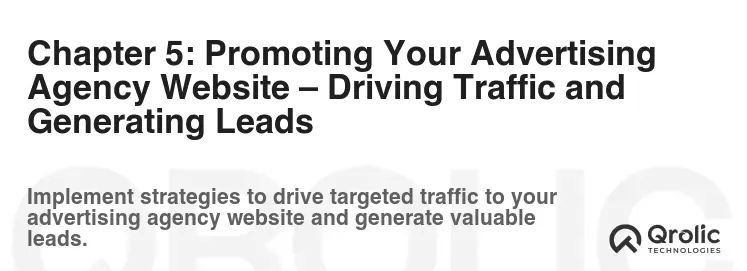
5.1 Search Engine Optimization (SEO): Ranking Higher in Search Results
SEO is the process of optimizing your website to rank higher in search engine results pages (SERPs).
- On-Page Optimization: Optimize your website content and structure for relevant keywords.
- Off-Page Optimization: Build high-quality backlinks from other websites.
- Local SEO: Optimize your website for local search by claiming your Google My Business listing.
- Content Marketing: Create and share valuable content to attract and engage your target audience.
5.2 Social Media Marketing: Engaging with Your Audience on Social Platforms
Social media marketing involves using social media platforms to promote your website and engage with your target audience.
- Choose the Right Platforms: Focus on the social media platforms that your target audience uses most.
- Share Valuable Content: Share valuable and engaging content that is relevant to your target audience.
- Engage with Your Followers: Respond to comments and messages and participate in relevant conversations.
- Run Social Media Ads: Use social media ads to reach a wider audience and drive traffic to your website.
5.3 Paid Advertising (PPC): Reaching a Targeted Audience with Paid Ads
Paid advertising (PPC) involves paying for ads that appear on search engines and other websites.
- Google Ads: Use Google Ads to target potential clients who are searching for your services.
- Social Media Ads: Use social media ads to target potential clients based on their demographics and interests.
- Retargeting Ads: Use retargeting ads to target visitors who have previously visited your website.
- Track Your Results: Track your results and optimize your campaigns to maximize your ROI.
5.4 Email Marketing: Nurturing Leads and Building Relationships
Email marketing involves using email to nurture leads and build relationships with your clients.
- Build an Email List: Offer valuable content or incentives in exchange for email addresses.
- Segment Your Email List: Segment your email list based on demographics, interests, and behavior.
- Send Targeted Emails: Send targeted emails that are relevant to each segment of your email list.
- Track Your Results: Track your results and optimize your email campaigns to maximize your ROI.
Chapter 6: Maintaining and Updating Your Website – Keeping Your Online Presence Fresh

6.1 Regular Content Updates: Keeping Your Website Fresh and Relevant
Regularly updating your website with fresh content is essential for keeping your website relevant and engaging.
- Blog Regularly: Publish new blog posts on a regular basis.
- Update Your Portfolio: Add new case studies and projects to your portfolio.
- Refresh Your Website Design: Periodically refresh your website design to keep it looking modern and up-to-date.
- Update Your Services Page: Update your services page to reflect any changes in your service offerings.
6.2 Monitoring Website Performance: Identifying and Addressing Issues
Regularly monitoring your website’s performance is essential for identifying and addressing any issues.
- Monitor Website Speed: Monitor your website’s speed and performance using tools like Google PageSpeed Insights.
- Check for Broken Links: Check for broken links on your website and fix them promptly.
- Monitor Website Security: Monitor your website’s security and address any security vulnerabilities.
- Track Your Analytics: Track your analytics to monitor your website’s traffic and user behavior.
6.3 Gathering Feedback and Making Improvements: Continuous Optimization
Gathering feedback from your clients and website visitors is essential for continuous optimization.
- Ask for Feedback: Ask your clients and website visitors for feedback on your website.
- Conduct User Testing: Conduct user testing to see how users interact with your website.
- Analyze Your Analytics: Analyze your analytics to identify areas for improvement.
- Make Data-Driven Decisions: Make data-driven decisions about how to improve your website.
Chapter 7: Qrolic Technologies: Your Partner in Digital Success

Qrolic Technologies (https://qrolic.com/) is a leading digital marketing agency that can help you create a stunning and effective website for your advertising agency. We offer a wide range of services, including:
- Website Design and Development: We create custom websites that are visually appealing, user-friendly, and optimized for search engines.
- Search Engine Optimization (SEO): We help you rank higher in search engine results pages (SERPs) and attract more organic traffic.
- Social Media Marketing: We help you engage with your audience on social media and build a strong online presence.
- Paid Advertising (PPC): We help you reach a targeted audience with paid ads and generate leads.
- Content Marketing: We help you create and share valuable content that attracts and engages your target audience.
Why Choose Qrolic Technologies?
- Expertise and Experience: We have a team of experienced digital marketing professionals who are passionate about helping businesses succeed online.
- Customized Solutions: We tailor our solutions to meet the specific needs of each client.
- Data-Driven Approach: We use data to inform our decisions and track our results.
- Results-Oriented: We are committed to delivering results that help our clients achieve their business goals.
Contact Qrolic Technologies today to learn more about how we can help you create a successful website for your advertising agency.
Chapter 8: Measuring Success – Key Performance Indicators (KPIs)
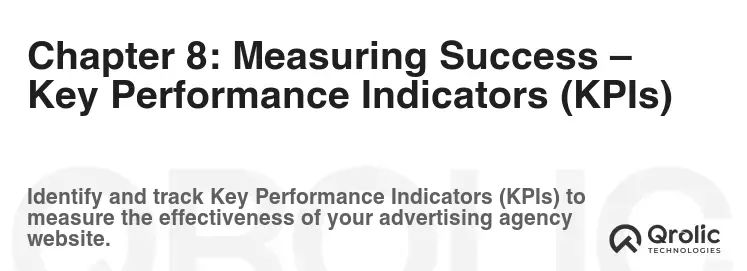
8.1 Defining Your KPIs: What Metrics Matter Most?
Before you can measure success, you need to define what success looks like. This means identifying the Key Performance Indicators (KPIs) that are most relevant to your advertising agency’s goals.
- Website Traffic: A fundamental metric that indicates the overall visibility of your website. Track both total traffic and traffic from different sources (organic, referral, social, etc.).
- Bounce Rate: The percentage of visitors who leave your website after viewing only one page. A high bounce rate suggests that your website is not engaging or relevant to visitors.
- Time on Page: The average amount of time visitors spend on each page of your website. Longer time on page indicates that visitors are engaged with your content.
- Conversion Rate: The percentage of visitors who complete a desired action, such as filling out a contact form, downloading a resource, or requesting a quote.
- Lead Generation: The number of leads generated through your website. This is a critical metric for advertising agencies, as leads are potential clients.
- Cost Per Lead (CPL): The average cost of generating a lead through your website. This metric helps you evaluate the effectiveness of your marketing campaigns.
- Client Acquisition Cost (CAC): The average cost of acquiring a new client through your website. This metric provides a holistic view of your marketing ROI.
- Return on Investment (ROI): The overall return on your investment in your website and marketing efforts.
8.2 Tools for Tracking KPIs: Leveraging Data for Insights
Several tools can help you track your KPIs and gain valuable insights into your website’s performance.
- Google Analytics: A free and powerful web analytics platform that provides detailed information about your website’s traffic, user behavior, and conversions.
- Google Search Console: A free tool that helps you monitor your website’s performance in Google search results.
- SEMrush/Ahrefs: Paid SEO tools that provide advanced keyword research, competitor analysis, and backlink analysis.
- CRM (Customer Relationship Management) Software: Helps you track leads, manage client relationships, and measure the effectiveness of your marketing efforts.
8.3 Analyzing Data and Making Adjustments: Continuous Improvement
Tracking KPIs is only the first step. You need to analyze the data and make adjustments to your website and marketing strategies based on your findings.
- Identify Trends: Look for patterns and trends in your data to identify areas where your website is performing well and areas where it needs improvement.
- A/B Testing: Conduct A/B tests to compare different versions of your website and identify which ones perform better.
- Optimize Your Content: Optimize your website content based on keyword research and user behavior data.
- Improve User Experience: Make improvements to your website’s user experience based on user feedback and analytics data.
- Refine Your Marketing Campaigns: Refine your marketing campaigns based on your lead generation and cost per lead data.
By consistently tracking your KPIs, analyzing your data, and making adjustments to your website and marketing strategies, you can ensure that your advertising agency website is continuously improving and delivering the results you need to succeed.






